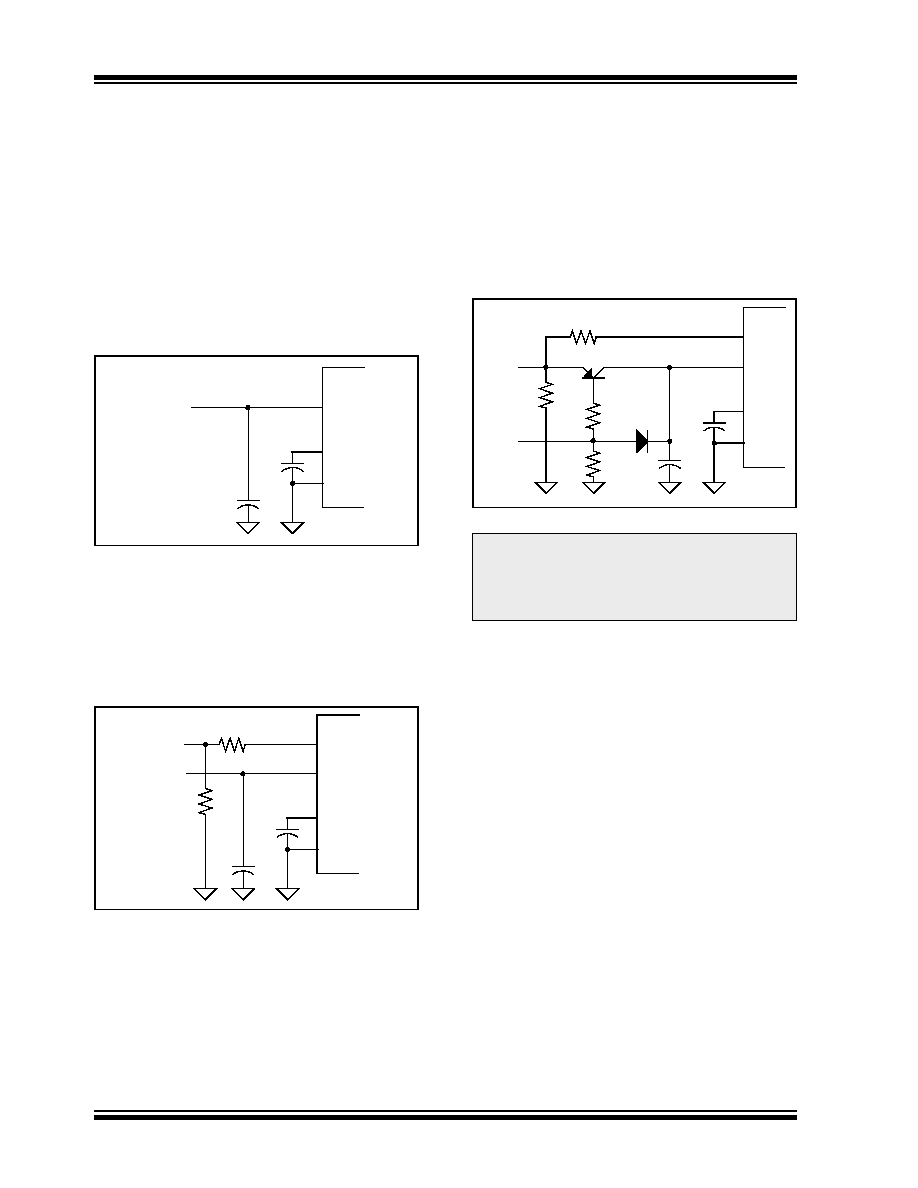- 您现在的位置:买卖IC网 > Sheet目录3875 > PIC16C55A-04/P (Microchip Technology)IC MCU OTP 512X12 28DIP

PIC18F2450/4450
DS39760A-page 148
Advance Information
2006 Microchip Technology Inc.
14.6
USB Power Modes
Many USB applications will likely have several different
sets of power requirements and configuration. The
most common power modes encountered are Bus
Power Only, Self-Power Only and Dual Power with
Self-Power Dominance. The most common cases are
presented here.
14.6.1
BUS POWER ONLY
In Bus Power Only mode, all power for the application
is drawn from the USB (Figure 14-10). This is
effectively the simplest power method for the device.
FIGURE 14-10:
BUS POWER ONLY
14.6.2
SELF-POWER ONLY
In Self-Power Only mode, the USB application provides
its own power, with very little power being pulled from
the USB. Figure 14-11 shows an example. Note that an
attach indication is added to indicate when the USB
has been connected.
FIGURE 14-11:
SELF-POWER ONLY
14.6.3
DUAL POWER WITH SELF-POWER
DOMINANCE
Some applications may require a dual power option.
This allows the application to use internal power prima-
rily, but switch to power from the USB when no internal
power is available. Figure 14-12 shows a simple Dual
Power with Self-Power Dominance example, which
automatically switches between Self-Power Only and
USB Bus Power Only modes.
FIGURE 14-12:
DUAL POWER EXAMPLE
14.7
Oscillator
The USB module has specific clock requirements. For
full-speed operation, the clock source must be 48 MHz.
Even so, the microcontroller core and other peripherals
are not required to run at that clock speed or even from
the same clock source. Available clocking options are
described in detail in Section 2.3 “Oscillator Settings
14.8
USB Firmware and Drivers
Microchip provides a number of application-specific
resources, such as USB firmware and driver support.
Refer to www.microchip.com for the latest firmware and
driver support.
VDD
VUSB
VSS
VBUS
~5V
VDD
VUSB
VSS
VSELF
~5V
I/O pin
Attach Sense
100 k
Ω
VBUS
~5V
100 k
Ω
Note:
Users should keep in mind the limits for
devices drawing power from the USB.
According to USB Specification 2.0, this
cannot exceed 100 mA per low-power
device or 500 mA per high-power device.
VDD
VUSB
I/O pin
VSS
Attach Sense
VBUS
VSELF
100 k
Ω
~5V
100 k
Ω
发布紧急采购,3分钟左右您将得到回复。
相关PDF资料
DSPIC30F3014T-20I/PT
IC DSPIC MCU/DSP 24K 44TQFP
DSPIC30F3014T-20I/ML
IC DSPIC MCU/DSP 24K 44QFN
PIC16LF819T-I/MLTSL
IC PIC MCU FLASH 2KX14 28QFN
PIC16LF819T-I/SOTSL
IC PIC MCU FLASH 2KX14 18SOIC
PIC18LF8410T-I/PT
IC PIC MCU FLASH 8KX16 80TQFP
PIC18F2410T-I/ML
IC PIC MCU FLASH 8KX16 28QFN
PIC18F2331T-E/SOG
IC PIC MCU FLASH 4KX16 28SOIC
PIC18F4331T-I/ML
IC MCU FLASH 4KX16 44QFN
相关代理商/技术参数
PIC16C55A-04/P
制造商:Microchip Technology Inc 功能描述:IC 8BIT CMOS MCU 16C55 DIP28
PIC16C55A-04/P
制造商:Microchip Technology Inc 功能描述:Microcontroller IC Number of I/Os:20
PIC16C55A-04/SO
功能描述:8位微控制器 -MCU .75KB 24 RAM 20 I/O 4MHz SOIC-28 RoHS:否 制造商:Silicon Labs 核心:8051 处理器系列:C8051F39x 数据总线宽度:8 bit 最大时钟频率:50 MHz 程序存储器大小:16 KB 数据 RAM 大小:1 KB 片上 ADC:Yes 工作电源电压:1.8 V to 3.6 V 工作温度范围:- 40 C to + 105 C 封装 / 箱体:QFN-20 安装风格:SMD/SMT
PIC16C55A-04/SO
制造商:Microchip Technology Inc 功能描述:8BIT CMOS MCU SMD 16C55 SOIC28
PIC16C55A-04/SP
功能描述:8位微控制器 -MCU .75KB 24 RAM 20 I/O 4MHz SPDIP-28 RoHS:否 制造商:Silicon Labs 核心:8051 处理器系列:C8051F39x 数据总线宽度:8 bit 最大时钟频率:50 MHz 程序存储器大小:16 KB 数据 RAM 大小:1 KB 片上 ADC:Yes 工作电源电压:1.8 V to 3.6 V 工作温度范围:- 40 C to + 105 C 封装 / 箱体:QFN-20 安装风格:SMD/SMT
PIC16C55A-04/SS
功能描述:8位微控制器 -MCU .75KB 24 RAM 20 I/O 4 MHz SSOP-28 RoHS:否 制造商:Silicon Labs 核心:8051 处理器系列:C8051F39x 数据总线宽度:8 bit 最大时钟频率:50 MHz 程序存储器大小:16 KB 数据 RAM 大小:1 KB 片上 ADC:Yes 工作电源电压:1.8 V to 3.6 V 工作温度范围:- 40 C to + 105 C 封装 / 箱体:QFN-20 安装风格:SMD/SMT
PIC16C55A-04E/P
功能描述:8位微控制器 -MCU .75KB 24 RAM 20 I/O RoHS:否 制造商:Silicon Labs 核心:8051 处理器系列:C8051F39x 数据总线宽度:8 bit 最大时钟频率:50 MHz 程序存储器大小:16 KB 数据 RAM 大小:1 KB 片上 ADC:Yes 工作电源电压:1.8 V to 3.6 V 工作温度范围:- 40 C to + 105 C 封装 / 箱体:QFN-20 安装风格:SMD/SMT
PIC16C55A-04E/SO
功能描述:8位微控制器 -MCU .75KB 24 RAM 20 I/O RoHS:否 制造商:Silicon Labs 核心:8051 处理器系列:C8051F39x 数据总线宽度:8 bit 最大时钟频率:50 MHz 程序存储器大小:16 KB 数据 RAM 大小:1 KB 片上 ADC:Yes 工作电源电压:1.8 V to 3.6 V 工作温度范围:- 40 C to + 105 C 封装 / 箱体:QFN-20 安装风格:SMD/SMT